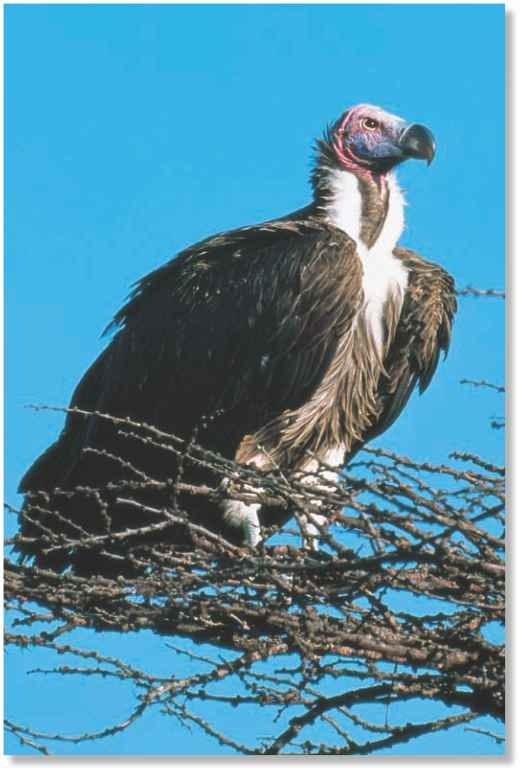ORDER
Falconiform.es
FAMILY
Accipitridae
GENUS & SPECIES
key features
• The lappet-faced vulture is the largest, and among the I rarest, of all of the African vultures
• Its lappets — loose folds of skin on its face — look like ears, hence its other common name, African eared vulture
• Has the strongest beak of any vulture, easily tearing into the tough hide of almost any animal
where in the world?
In Africa, from the Sahara, east to Ethiopia, south through Kenya, Tanzania and into South Africa, and west to the Namib Desert; also the deserts of Israel and the Arabian Peninsula

Lifecycle
Other vultures gather around tough-hided carrion and wait for the lappet-faced vulture, the most powerful of all of the vultures, to arrive and rip the carcass open with its beak.
HABITAT
The lappet-faced vulture prefers the bright sun and warmth of the semi-arid deserts and savannahs of Africa, Israel and the Arabian Peninsula. This massive bird frequents open desert areas with desert scrub; it nests in the shortest trees in the area, commonly thorny acacias. These large, open areas with little cover make it easier for the lappet-faced vulture to spot the dead and dying animals upon which it feeds. Though quite dominant at feeding sites, the lappet-faced vulture prefers to build a solitary nest, away from other breeding pairs.
Wide, open spaces The lappet-faced vulture relies on large, open areas for hunting.
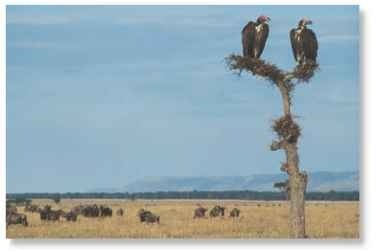
• It is thought that some nonindigenous species of plants and trees in the Negav Desert area of Israel were brought there as seeds on the feet of migrating lappet-faced vultures.
The vulture’s bare head is thought to be an adaptation to prevent germs and bacteria, acquired when sticking its head into putrid carcasses, from causing infections. A head covered with feathers is harder to clean thoroughly.
FOOD & FEEDING
The lappet-faced vulture is a voracious eater and is capable of cleaning a carcass down to the bones. When it locates a piece of carrion, it uses its powerful beak to rip holes in the animal’s tough hide. The vulture’s long neck allows it to probe deep into carrion in search of the large meaty muscles. It then rips off large pieces of meat while holding the carcass with its feet. The largest of all vultures, the lappet-faced is well respected at carrion sites — other animals, including hyenas, are easily driven away when confronted. Due to the scarcity of carrion, especially in the desert areas, the vulture feeds heavily at each sitting, and its crop, an enlargement of the esophagus, can store more than 13 lbs. of food at a time. Once food is digested, the lappet-faced vulture, like all birds of prey, regurgitates pellets of hair and feathers. Although largely a scavenger, it also hunts live game when carrion is scarce. Its prime targets are flamingos, both young and adult, hares, gazelle calves and even locusts and termites.
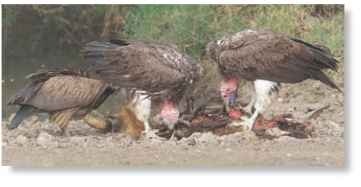
BEHAVIOR
The lappet-faced vulture is one of the shiest and most solitary of the Old World vultures —except when feeding. Then, the vultures congregate, occasionally gathering in groups of up to 100 birds. Once, 35 lappet-faced vultures were observed surrounding a single dead donkey. The lappet-faced vulture is normally a silent bird but, when gathered around a piece of carrion, it grunts, growls, hisses and yelps. The strongest and most dominant vulture at kill sites, it can easily bully other vultures and even the largest eagle into submission. It usually moves to the outskirts of the feeding group and attacks others by rushing toward them with its head lowered and wings and neck outstretched. The lappet-faced vulture regularly visits water holes, where it washes off its messy face after eating.
Back off! The vulture protects its meal from other animals.
COMMANDER IN CHIEF
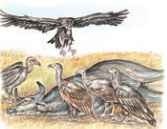
Needy citizens…
Many vultures are not strong enough to rip through the tough hide of a buffalo, and rely on the lappet-faced vulture to do so.
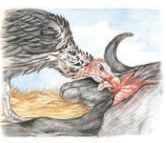
Saving the day…
With the largest and one of the most powerful beaks, the lappet-faced vulture easily tears through the hide of almost any animal.
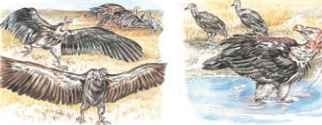
First in line…
The immense lappet-faced vulture commands the scene; it is the first to eat and even takes food from the others.
A job well done!
After a meal, the lappet-faced vulture finds a water hole where it can bathe and wash off the mess from its head and neck.
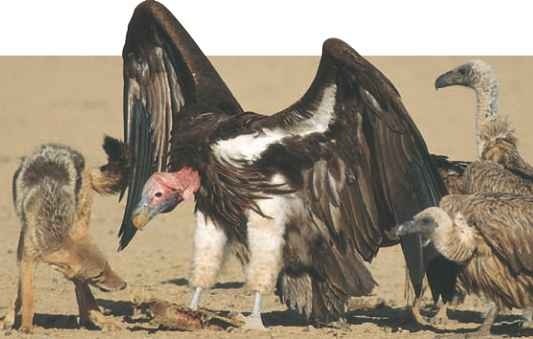
BREEDING
Lappet-faced vultures are solitary nesters and prefer to be far away from other nesting pairs. Intensive nest defense, mate-guarding and courtship-feeding are all part of the mating rituals. Both the male and female lappet-faced vulture work together to build a massive nest of sticks, up to 10′ in diameter, usually atop a thorny tree in the open sun. Once the base of the nest is built, they line it with fur from carcasses and grass. During the nest’s construction the pair roosts nearby; even when the nest is finished, they will not use the nest until the egg is laid. The female lays one dull-white egg with brown spots and blotches, and the male and female take turns incubating the egg and searching for food. The chick hatches after about 55 days; one parent remains with the chick, while the other scavenges for food. The adults feed the chick regurgitated carrion, including splinters of bone that provide essential calcium. After about I 35 days, the young lappet-faced vulture takes its first flight.The adults often return to the same nest for several years.
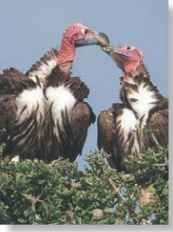
A Working together Both members of a breeding pair share in the parental duties.
CONSERVATION
Though not currently on the endangered list, the lappet-faced vulture is declining in southern Africa because of poisoning and shooting, electrocution by high-voltage towers and a shortage of calcium in the diet of chicks. It is listed in Appendix II of CITES, which strictly controls its export out of Africa.
PROFILE
Lappet-faced Vulture
With its strong beak, broad wings and featherless neck and head, the lappet-faced vulture is well suited for finding and feeding on carrion.
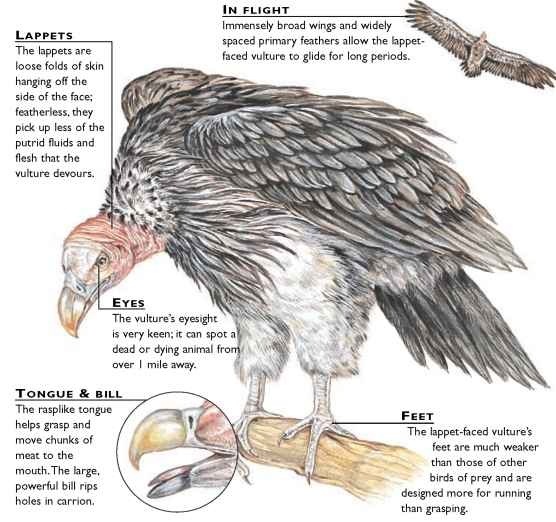
CREATURE COMPARISONS
The white-headed vulture (Jrigonoceps occipitalis) has a wingspan of 6.5′ and length of 2.75′, much smaller than those of the lappet-faced vulture.The white-headed is one of the most colorful White-headed vultures in Africa; it has a downy, white head, bright vulture orange and blue beak, pink legs and face, and white secondary feathers and tail leading up the middle of the wing.The white-headed vulture is known as “the searcher” since it sets out earlier in the day in search of food than do other vultures. It is often forced to the outskirts of feeding groups when other vulture species arrive and is left to eat the less nutritious scraps.
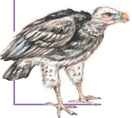
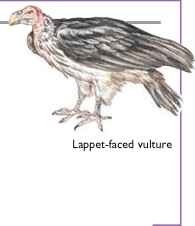
| vital statistics | |
| Weight | 12-21 lbs. |
| Length | 3-4′ |
| Wingspan | 9-9.5′ |
| Sexual Maturity | About 6-9 years |
| Breeding § Season | Varies with location |
| Number of Eggs | 1-2; usually |
| Incubation . Period | 54-56 days |
| Fledging Period | 125-135 days |
| Breeding Interval | “1 year |
| Typical Diet | Mostly carrion; also hunts flamingos, hares and insects |
| Lifespan | About 40 years |
Related species
The lappet-faced vulture is 1 of 15 species of Old World vultures in the family Accipitridae, found across Africa, Europe and Asia. They are joined by the New World vultures in the family Cathartidae in the order Falconiformes. But the Old World vultures actually are more closely related to hawks and eagles, also in the family Accipitridae, than to the New World vultures.
